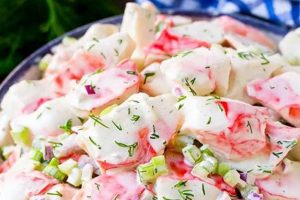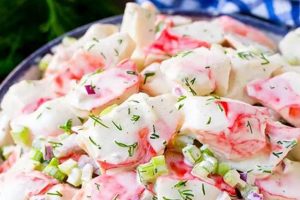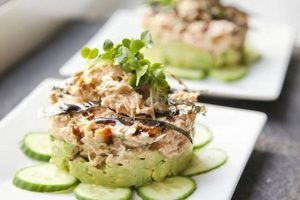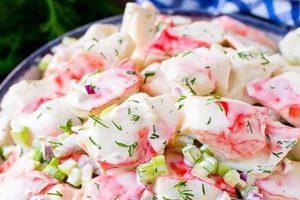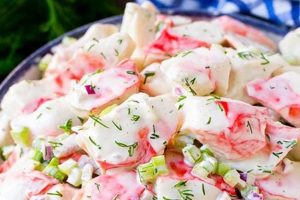A dish comprised of cooked crab meat, combined with various complementary ingredients, often including mayonnaise, vegetables, and seasonings, forms a chilled salad. Variations range from simple mixtures suitable for sandwiches to more elaborate presentations served as appetizers or light entrees. A classic example features lump crab meat, celery, red onion, mayonnaise, Dijon mustard, lemon juice, and Old Bay seasoning.
Chilled seafood salads offer a refreshing and flavorful option, particularly during warmer months. The nutritional value varies depending on the specific ingredients, with crab meat being a good source of protein and certain minerals. Historically, such salads gained popularity as a method of preserving and utilizing readily available seafood. The evolution of refrigeration technologies allowed for further refinement and expansion of these dishes, leading to the diverse array of preparations enjoyed today.
The following sections will delve into specific ingredient selections, preparation techniques, and serving suggestions for crafting exceptional crab salads. Further topics will include variations on classic recipes, addressing dietary restrictions, and exploring suitable accompanying dishes.
Tips for Exceptional Crab Meat Salad
Achieving optimal flavor and texture in crab salad relies on careful ingredient selection and proper handling techniques. The following tips offer guidance for crafting a superior dish.
Tip 1: Freshness is Paramount: Opt for the freshest crab meat available, preferably pasteurized lump or jumbo lump crab for optimal texture and flavor. Avoid canned crab, as it often exhibits a watery consistency and inferior taste.
Tip 2: Gentle Handling: Crab meat is delicate. Avoid overmixing, which can break down the meat and result in a mushy texture. Fold ingredients together gently until just combined.
Tip 3: Balancing Flavors: The key to a delicious crab salad lies in a balanced flavor profile. Acidity from lemon juice or vinegar complements the sweetness of the crab, while seasonings like Old Bay or Dijon mustard provide depth.
Tip 4: Mayonnaise Matters: High-quality mayonnaise is crucial. Consider using a homemade version or a premium brand for a richer, creamier result. Start with a small amount and add more as needed to avoid an overly heavy salad.
Tip 5: Textural Variety: Incorporating finely diced vegetables like celery and red onion provides textural contrast and enhances the overall flavor profile. Experiment with other additions, such as bell peppers or chopped water chestnuts.
Tip 6: Proper Chilling: Allow the salad to chill thoroughly in the refrigerator for at least 30 minutes before serving. This allows the flavors to meld and the salad to firm up.
Tip 7: Consider the Serving Vessel: Crab salad can be served in a variety of ways, from atop lettuce cups or crackers to stuffed into avocados or tomatoes. Choose a vessel that complements the salad’s delicate nature.
By adhering to these guidelines, one can elevate crab salad from a simple dish to a culinary delight. Careful attention to detail ensures a balanced, flavorful, and texturally pleasing experience.
These techniques will enable the creation of truly exceptional crab salad. The final section will offer concluding remarks and additional resources for further exploration.
1. High-quality Crab Meat
High-quality crab meat forms the foundation of a successful crab meat salad. Its importance stems from its direct influence on flavor, texture, and overall culinary experience. Using inferior crab meat, such as canned or heavily processed varieties, often results in a watery, bland salad lacking the delicate sweetness and firm texture characteristic of fresh, high-quality crab. This choice can compromise even the most carefully crafted recipe, overshadowing complementary ingredients and diminishing overall enjoyment. Conversely, premium crab meat, such as jumbo lump or lump crab, elevates the dish, providing a succulent, flavorful centerpiece that harmonizes with other components.
Consider the difference between a salad made with freshly picked, expertly cooked, and hand-picked lump crab meat versus one made with canned, shredded crab. The former offers a clean, sweet taste and a pleasingly firm texture, allowing the nuances of other ingredients to shine. The latter, however, may impart a fishy or metallic taste and a mushy texture that detracts from the overall experience, regardless of the quality of other components like mayonnaise or seasonings. Choosing high-quality crab meat also impacts food safety. Fresh, properly handled crab minimizes the risk of bacterial contamination, ensuring a safe and enjoyable culinary experience.
Understanding the pivotal role of high-quality crab meat in a crab meat salad recipe empowers informed culinary decisions. It underscores the value of sourcing the best possible ingredients and highlights the detrimental impact of compromising on quality. Prioritizing premium crab meat ensures a superior culinary outcome, transforming a simple salad into a truly exceptional dish. This principle extends beyond crab salad, underscoring the fundamental importance of ingredient quality in all culinary endeavors.
2. Balanced Flavor Profile
A balanced flavor profile is essential for a successful crab meat salad recipe. The delicate sweetness of crab meat requires careful consideration of complementary and contrasting flavors. Without balance, the salad can become bland, overly sweet, or excessively tangy. A harmonious blend of flavors elevates the dish from simple to exceptional. This balance hinges on the interplay of several key taste components: salinity, acidity, richness, and subtle sweetness.
Salinity, often provided by salt or ingredients like capers or olives, enhances the natural sweetness of the crab. Acidity, typically from lemon juice or vinegar, cuts through the richness of the mayonnaise and brightens the overall flavor. The richness of mayonnaise or other creamy dressings provides a smooth, luxurious mouthfeel that complements the delicate texture of the crab. A touch of sweetness, sometimes added through a pinch of sugar or a sweeter onion variety, further enhances the crab’s natural sweetness. For example, a crab salad featuring lump crab meat, finely diced celery, red onion, mayonnaise, Dijon mustard, lemon juice, and a pinch of Old Bay seasoning exemplifies a balanced flavor profile. The celery and red onion offer a subtle sweetness and crunch, the mayonnaise provides richness, the Dijon mustard adds a touch of tang, the lemon juice contributes brightness, and the Old Bay seasoning delivers a savory depth. The subtle interplay of these ingredients creates a harmonious and satisfying experience.
Understanding the importance of a balanced flavor profile empowers informed ingredient selection and adjustment. Recipes serve as guidelines, but palates vary. Tasting and adjusting seasonings throughout the preparation process are crucial for achieving the desired balance. This awareness transforms a simple assembly of ingredients into a nuanced culinary creation, enhancing the enjoyment and appreciation of crab meat salad. Furthermore, this principle extends beyond crab salad, applying to a broad range of culinary endeavors where achieving flavor balance is paramount.
3. Appropriate Textural Elements
Textural elements contribute significantly to the overall enjoyment of crab meat salad. A successful recipe considers the interplay of textures, balancing the delicate nature of the crab meat with contrasting elements to create a more engaging culinary experience. Ignoring textural variety can result in a monotonous, one-dimensional dish, regardless of how well-balanced the flavors are. Careful consideration of textural elements elevates the salad from merely palatable to truly delightful.
- Crunchy Elements
Crunchy components provide a counterpoint to the soft texture of crab meat. Common examples include finely diced celery, water chestnuts, or chopped bell peppers. These additions introduce a satisfying contrast, preventing the salad from becoming overly soft or mushy. The crispness of these ingredients also adds a refreshing element, enhancing the overall sensory experience. Imagine the difference between a crab salad solely comprised of crab and mayonnaise versus one that includes the bright, crisp snap of celery the latter offers a more dynamic and enjoyable textural profile.
- Soft Elements
While crunchy elements are crucial, softer components also play a role. Avocado, for example, provides a creamy texture that complements the richness of the mayonnaise and contrasts with the crunchier vegetables. The softness of avocado also helps bind the salad, creating a more cohesive texture. This interplay of soft and crunchy elements is key to a well-rounded crab salad.
- Size and Shape
The size and shape of ingredients also influence texture. Uniformly diced ingredients create a consistent mouthfeel, while varying the size and shape introduces more complexity. Consider a salad with finely diced celery and larger chunks of avocado the varying sizes offer a more interesting textural experience. Similarly, the delicate flakes of crab meat contrast with the smaller dice of vegetables, creating a multi-faceted texture.
- Fresh Herbs
Fresh herbs, such as dill, chives, or parsley, contribute both flavor and textural nuance. Their delicate leaves add a subtle textural variation, while their bright flavors complement the crab. The subtle interplay of flavors and textures further enhances the overall sensory experience. Fresh herbs provide a final layer of complexity, elevating the crab salad from simple to sophisticated.
The careful integration of these textural elements transforms crab meat salad from a simple dish into a multi-sensory culinary experience. The interplay of crunchy, soft, and varied shapes and sizes creates a dynamic and engaging texture that complements the delicate flavor of the crab. Understanding and applying these principles elevates the final product, demonstrating the importance of textural considerations in crafting a truly exceptional crab meat salad.
4. Proper Chilling and Storage
Proper chilling and storage are critical for both food safety and optimal flavor in a crab meat salad recipe. Crab meat, being highly perishable, is susceptible to bacterial growth if not maintained at appropriate temperatures. Chilling the salad promptly after preparation inhibits bacterial proliferation, mitigating the risk of foodborne illnesses. Furthermore, chilling allows the flavors of the various ingredients to meld and deepen, resulting in a more complex and nuanced taste profile. A well-chilled crab salad offers a refreshing and enjoyable culinary experience, while inadequate chilling can lead to both safety concerns and a diminished sensory experience.
The impact of chilling extends beyond mere food safety. Chilling affects the texture and structural integrity of the salad. Cold temperatures firm the crab meat and other ingredients, enhancing the overall texture and preventing the salad from becoming watery or mushy. This is particularly important when serving the salad on bread or crackers, where excess moisture can lead to sogginess. Additionally, chilling helps stabilize the emulsion of mayonnaise-based dressings, preventing separation and maintaining a desirable creamy consistency. For instance, a crab salad left at room temperature for an extended period might exhibit a separated dressing and a softer, less appealing texture compared to its properly chilled counterpart. This difference underscores the practical significance of proper chilling in achieving the desired culinary outcome.
Optimal storage practices further ensure the longevity and quality of crab meat salad. Storing the salad in an airtight container in the refrigerator maintains its freshness and prevents it from absorbing odors from other foods. Ideally, crab meat salad should be consumed within two days of preparation for optimal quality and safety. Freezing, while possible, is generally not recommended as it can negatively impact the texture of the crab meat, resulting in a drier, less desirable consistency upon thawing. Adhering to these chilling and storage guidelines safeguards against spoilage, preserves optimal flavor and texture, and maximizes the shelf life of the prepared dish. This attention to detail demonstrates a commitment to both culinary excellence and food safety best practices.
5. Considerate Presentation
Considerate presentation elevates crab meat salad from a simple dish to a visually appealing culinary creation. Presentation encompasses plating, garnishing, and the overall aesthetic appeal, significantly impacting perceived value and enjoyment. A thoughtfully presented salad entices the appetite and enhances the dining experience, while a careless presentation can diminish even the most flavorful preparation. This principle stems from the understanding that dining is a multi-sensory experience, where visual appeal plays a crucial role alongside taste and texture.
Several factors contribute to considerate presentation. The choice of serving vessel significantly influences visual impact. Serving crab salad in a hollowed-out avocado, atop crisp lettuce cups, or in elegant stemmed glasses creates a more refined presentation than simply placing it in a bowl. Garnishes further enhance visual appeal and provide complementary flavors. Fresh herbs, such as dill or chives, add a touch of color and a bright, herbaceous note. A sprinkle of paprika or a drizzle of olive oil can add visual interest and enhance the salad’s richness. For example, a crab salad served in a chilled martini glass, garnished with a sprig of dill and a lemon wedge, presents a far more elegant and appealing image than the same salad served in a plain bowl. This difference highlights the impact of presentation on perceived quality and enjoyment.
The practical significance of considerate presentation extends beyond mere aesthetics. Thoughtful plating can influence portion control and encourage balanced eating. Serving smaller portions in attractive vessels can create a sense of abundance while managing calorie intake. Furthermore, a visually appealing presentation can make a dish more enticing to children or those with diminished appetites. Understanding the principles of considerate presentation allows one to transform a simple crab meat salad into a visually captivating and enjoyable culinary experience. This attention to detail not only enhances the dining experience but also demonstrates a commitment to culinary artistry, elevating the perception of even the most straightforward dishes.
Frequently Asked Questions
This section addresses common inquiries regarding crab meat salad preparation, storage, and variations.
Question 1: What type of crab meat is best suited for crab salad?
Jumbo lump or lump crab meat is generally preferred for its delicate flavor and texture. While other varieties, such as backfin or claw meat, are acceptable, they may yield a slightly different texture and flavor profile. Canned crab meat is generally discouraged due to its often inferior taste and watery consistency.
Question 2: How long can crab meat salad be stored in the refrigerator?
For optimal quality and food safety, crab meat salad should be consumed within two days of preparation. Ensure proper storage in an airtight container to maintain freshness and prevent contamination.
Question 3: Can crab meat salad be frozen?
Freezing is not generally recommended. Freezing can negatively impact the texture of the crab meat, resulting in a drier, less desirable consistency upon thawing.
Question 4: What can be used as a substitute for mayonnaise in crab salad?
Plain Greek yogurt or a mixture of Greek yogurt and mayonnaise can offer a lighter alternative while still providing a creamy texture. Avocado can also be incorporated for a richer, dairy-free option.
Question 5: How can one prevent crab meat salad from becoming watery?
Using high-quality, well-drained crab meat is crucial. Ensure all vegetables are thoroughly dried before incorporating them into the salad. Proper chilling also helps maintain the desired texture and prevents excess moisture.
Question 6: What are some common allergens to be aware of in crab meat salad?
Shellfish allergy is the primary concern. Individuals with shellfish allergies should avoid crab meat salad entirely. Additionally, ingredients such as mayonnaise, dairy products, and gluten-containing ingredients (if used) may pose allergic risks for certain individuals.
Addressing these common questions empowers informed culinary decisions, ensuring both a safe and enjoyable crab meat salad experience.
This concludes the frequently asked questions section. The following section will offer concluding remarks.
Conclusion
This exploration of crab meat salad recipes has provided comprehensive insights into crafting this culinary delight. Key aspects, including ingredient selection, flavor balancing, textural considerations, chilling and storage practices, and presentation techniques, have been thoroughly examined. Emphasis has been placed on the importance of using high-quality crab meat, achieving a harmonious flavor profile, incorporating appropriate textural elements, and understanding the critical role of proper chilling and storage in maintaining both safety and optimal culinary quality. The impact of presentation on perceived value and overall enjoyment has also been underscored.
Culinary success hinges on a thorough understanding of these fundamental principles. Application of this knowledge allows one to transcend basic recipes, transforming simple ingredients into exceptional culinary experiences. Continued exploration and experimentation with various ingredients and techniques are encouraged to further refine one’s understanding and mastery of crab meat salad preparation.

